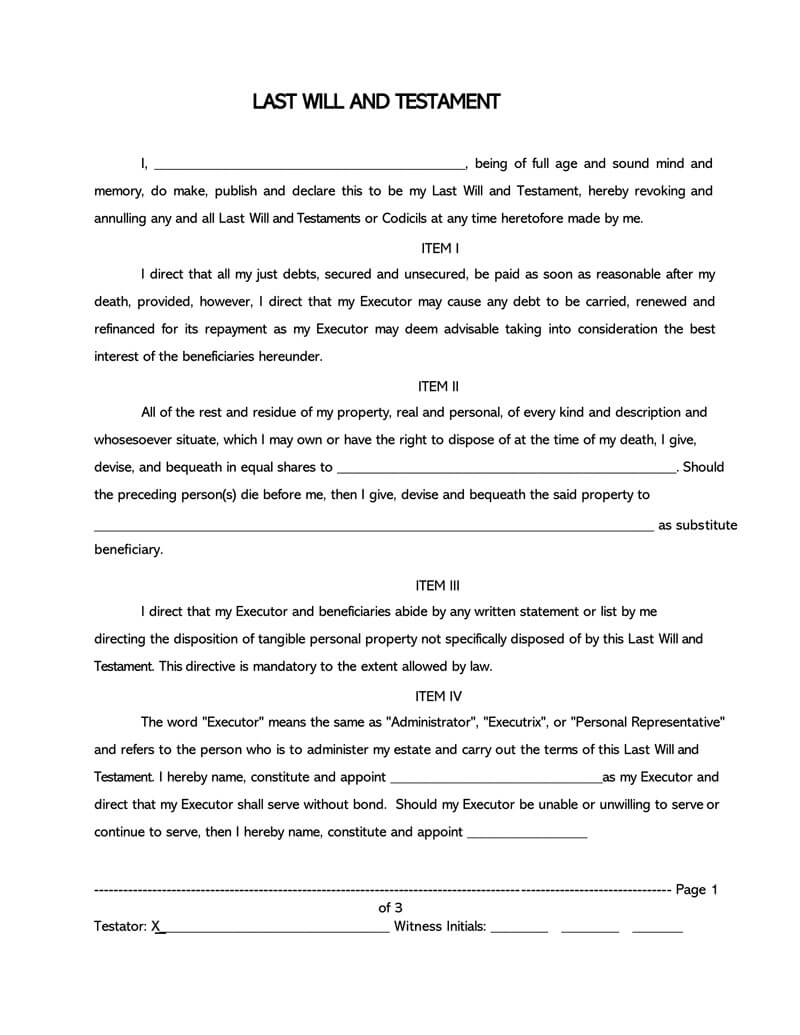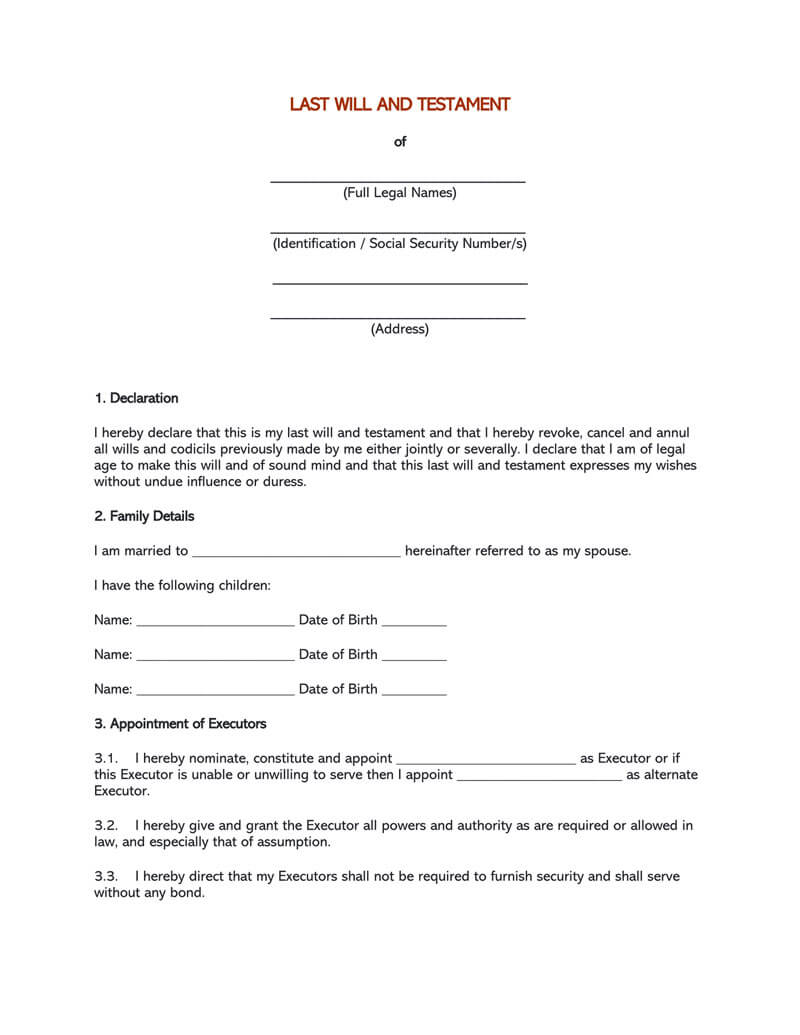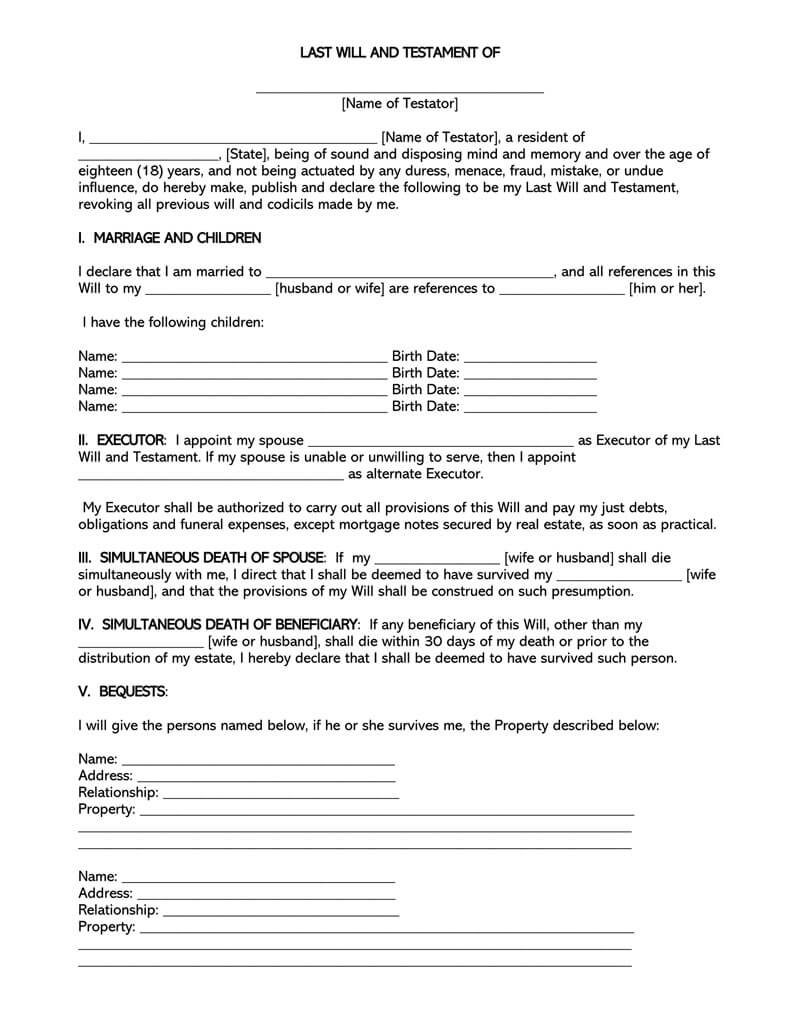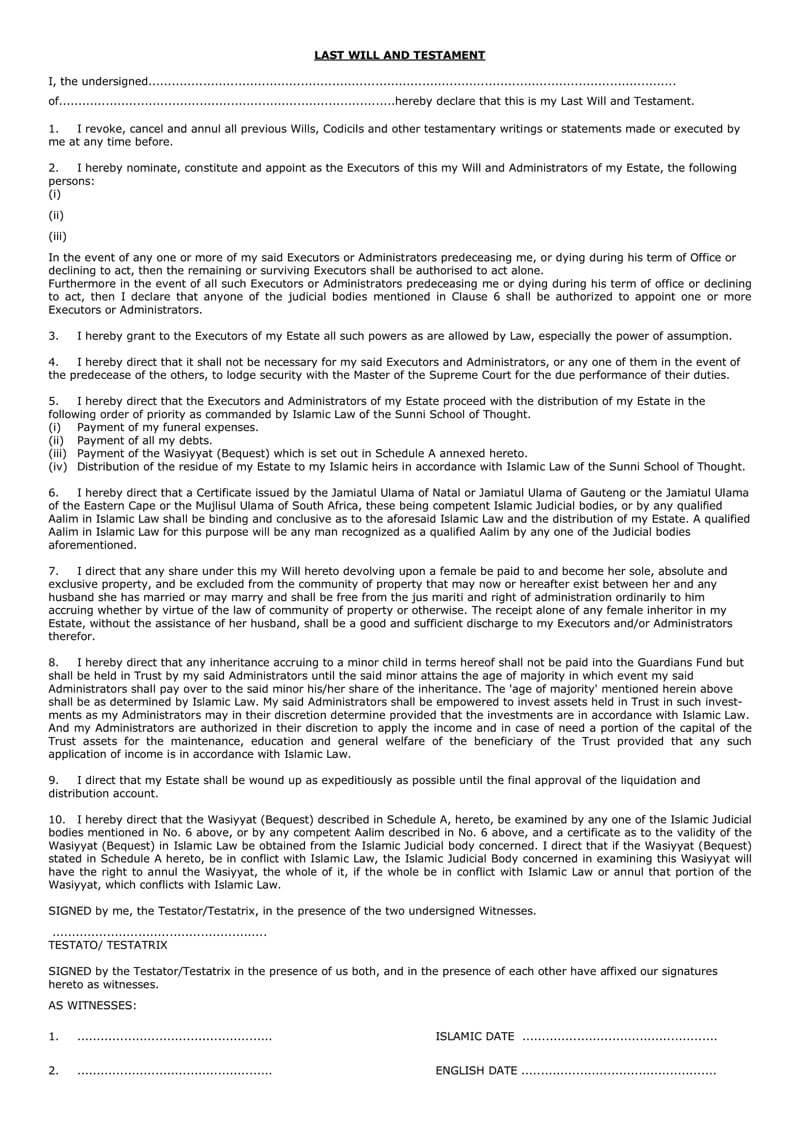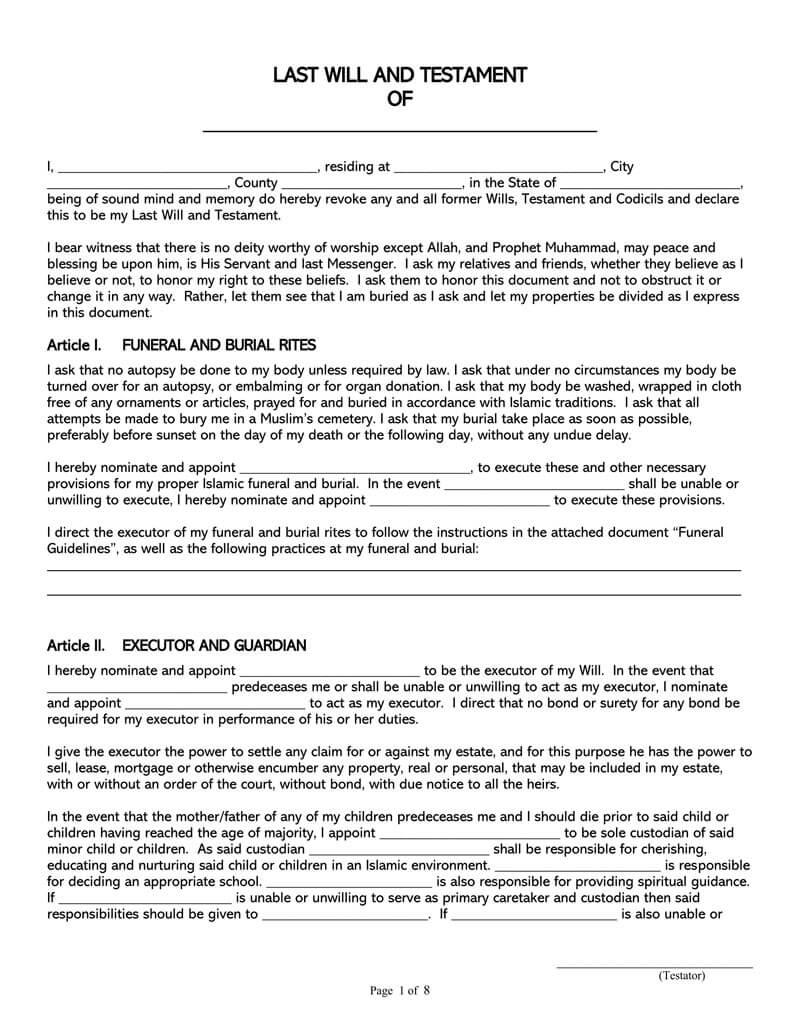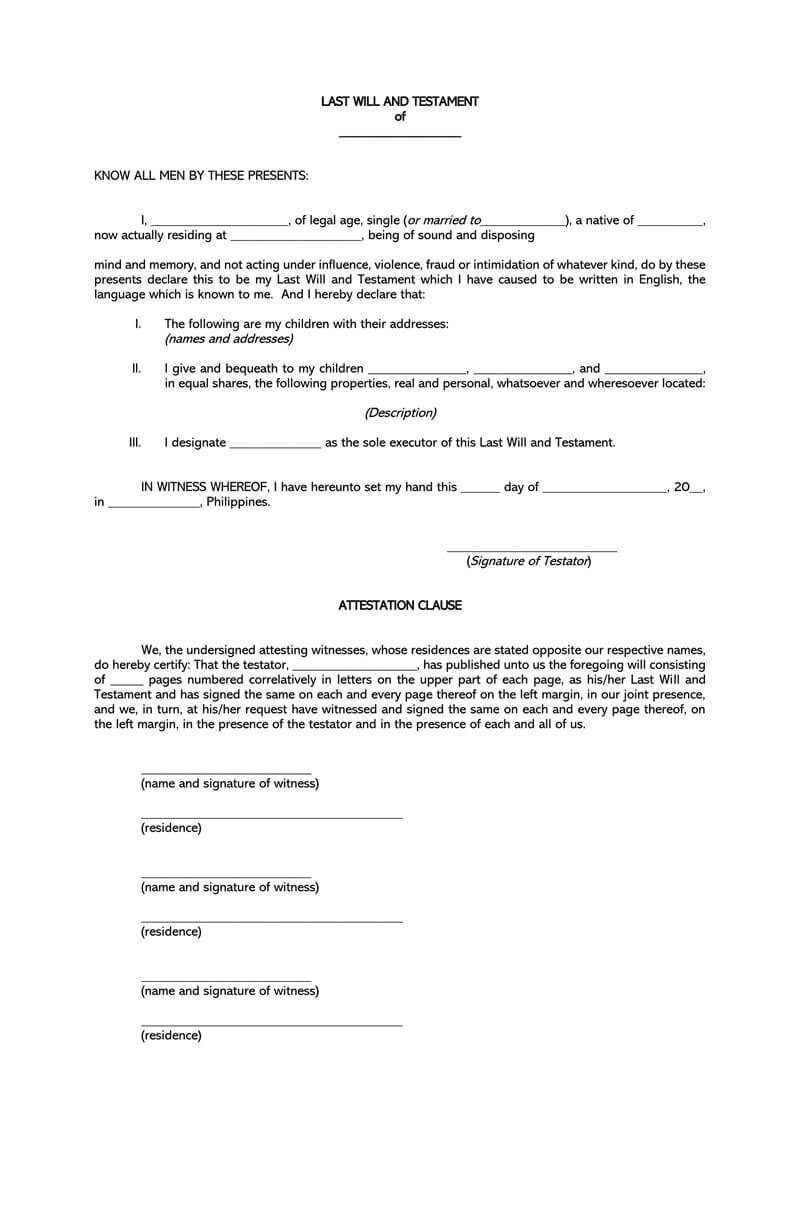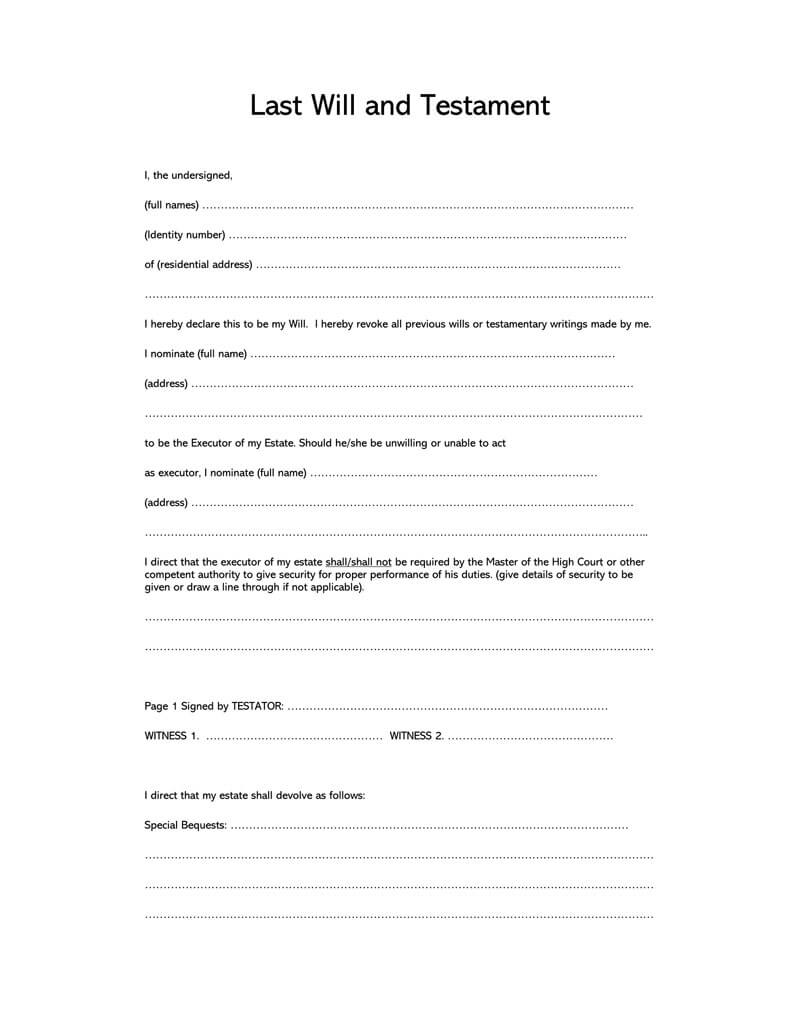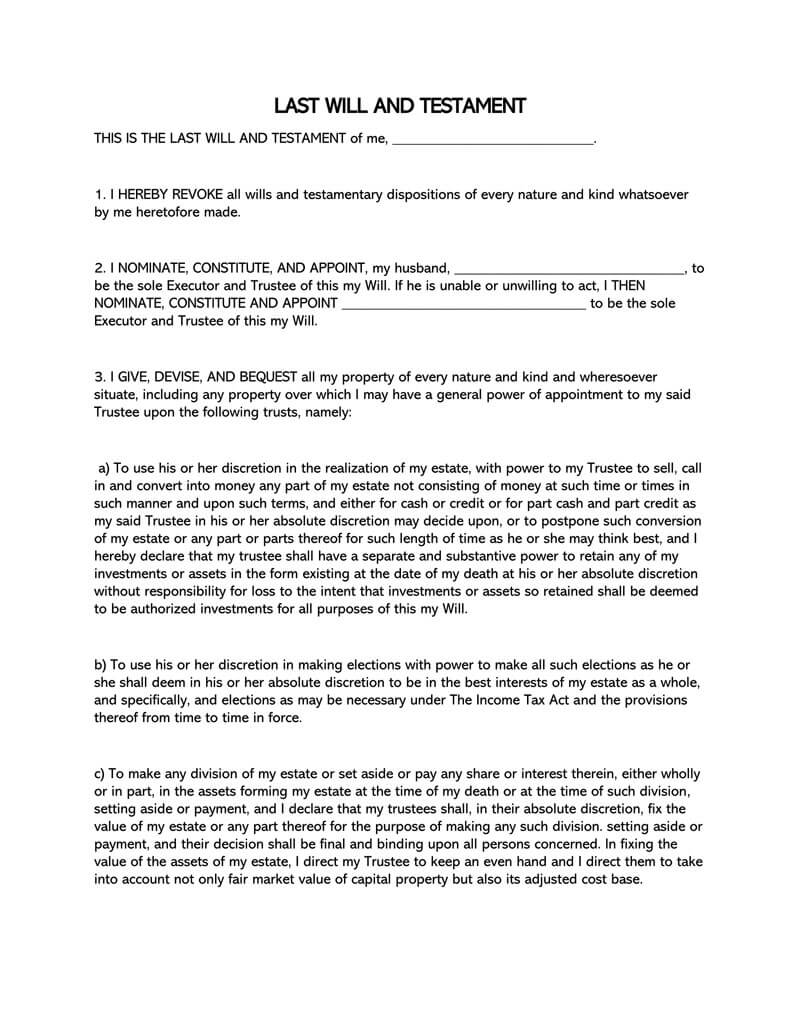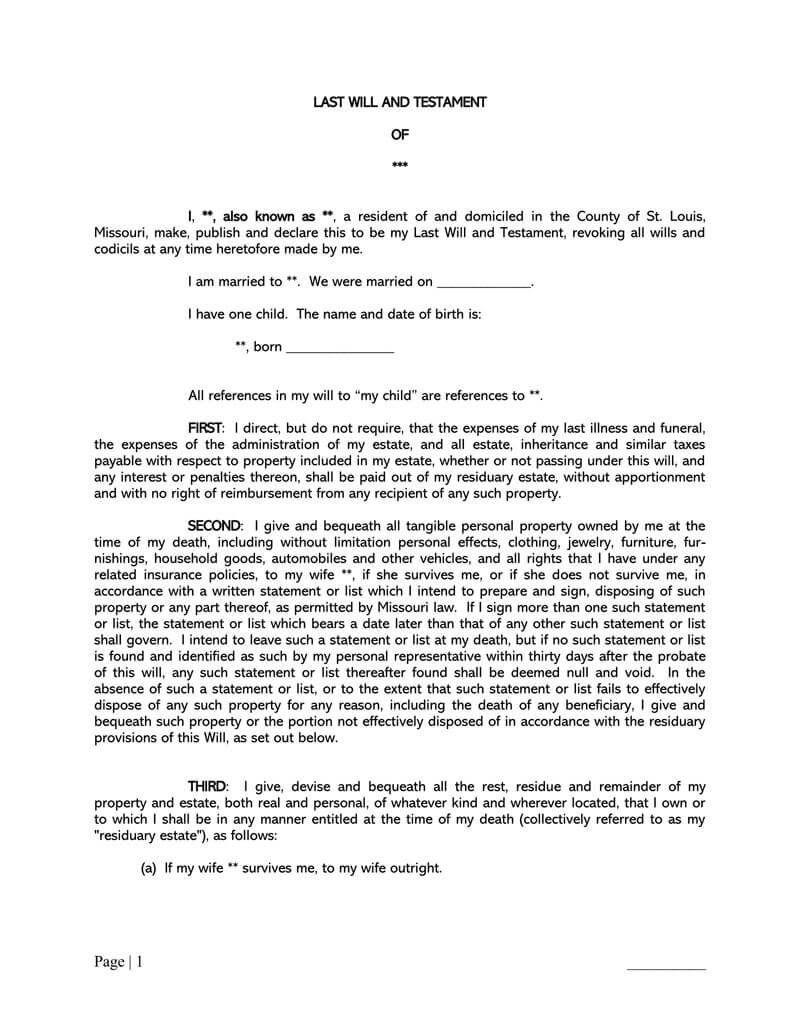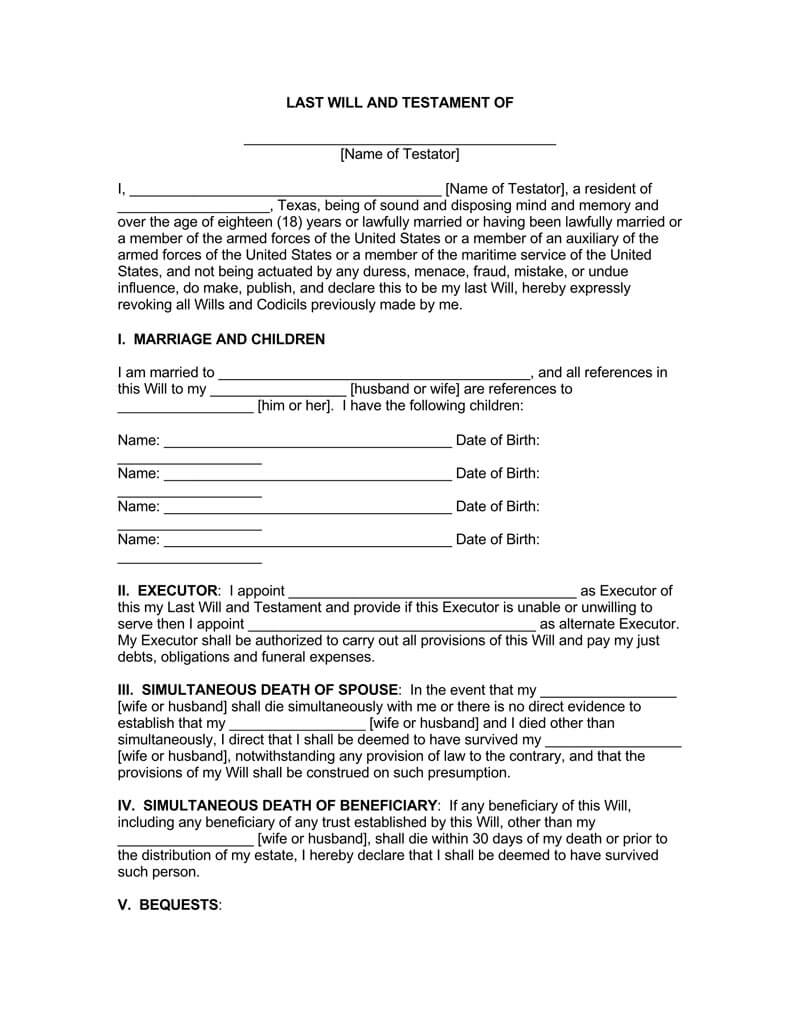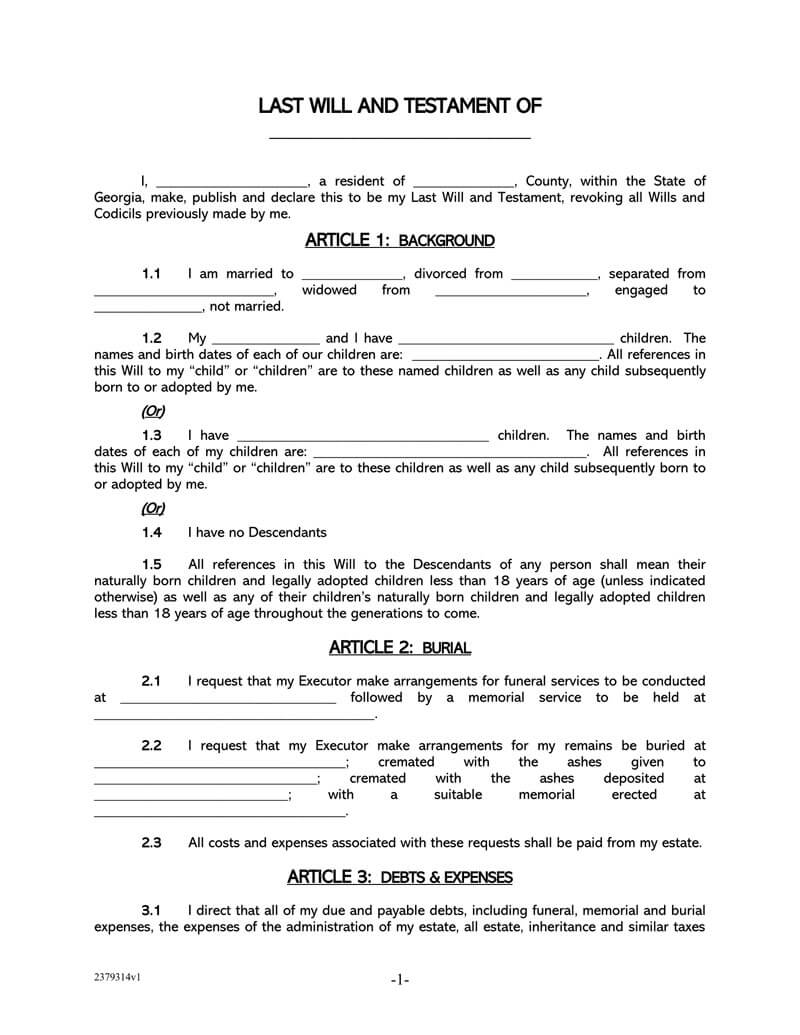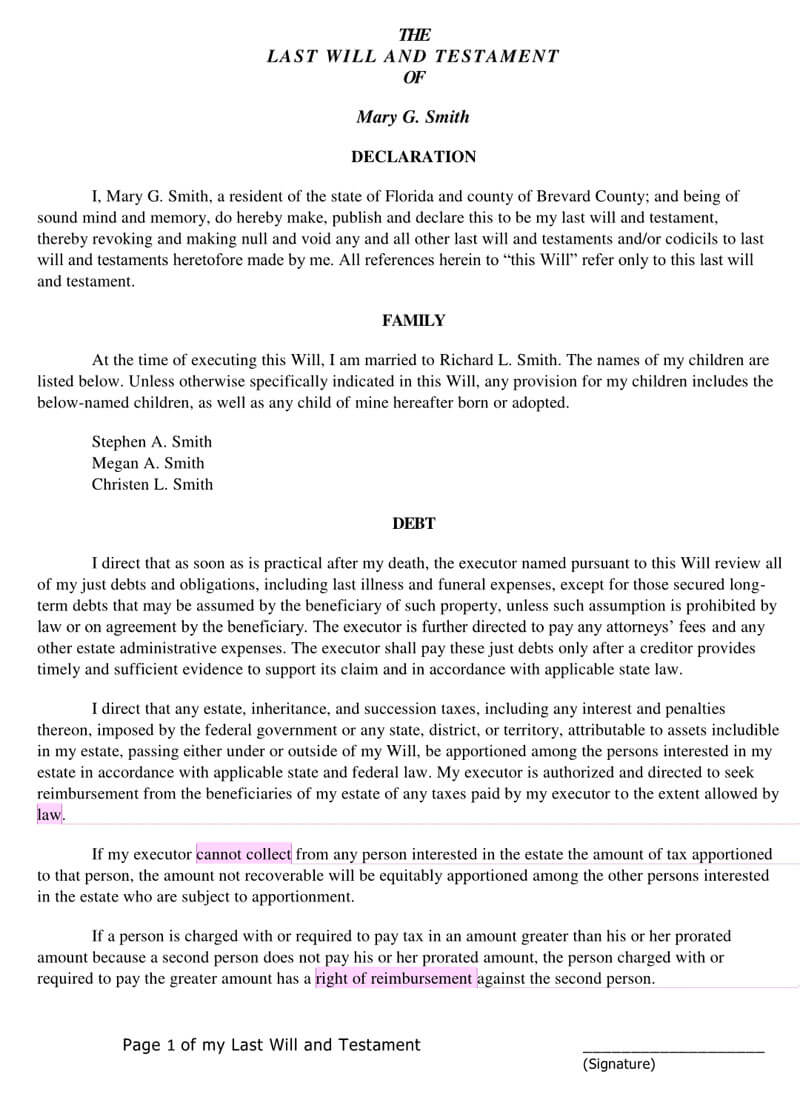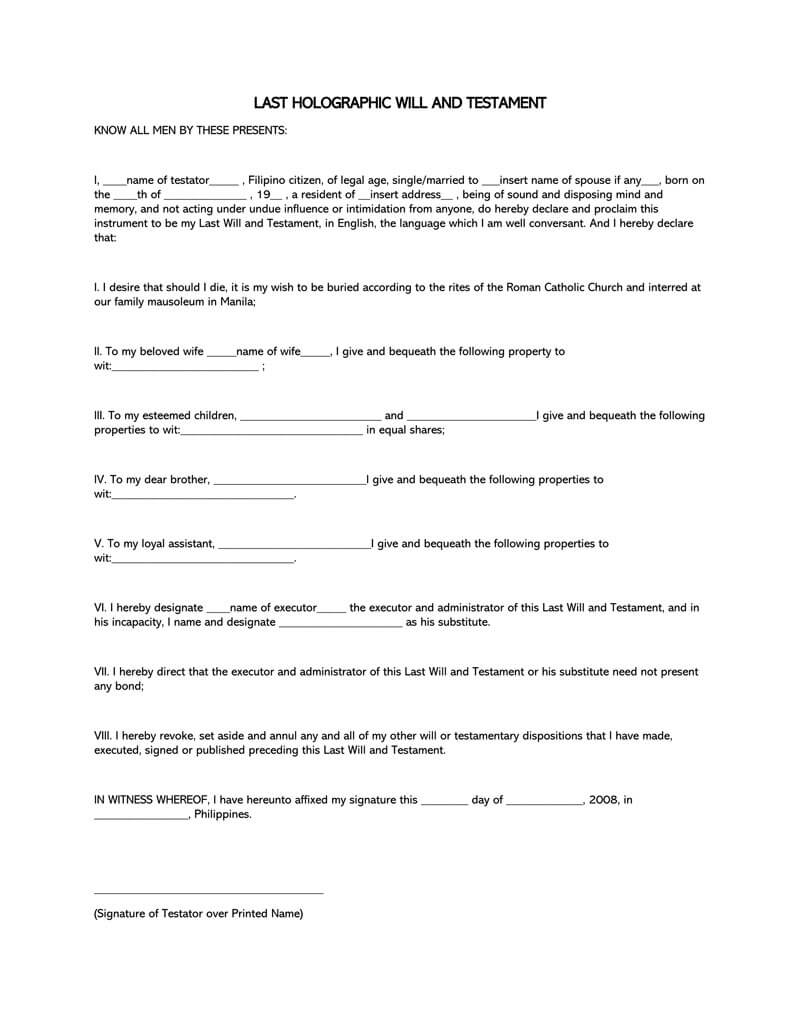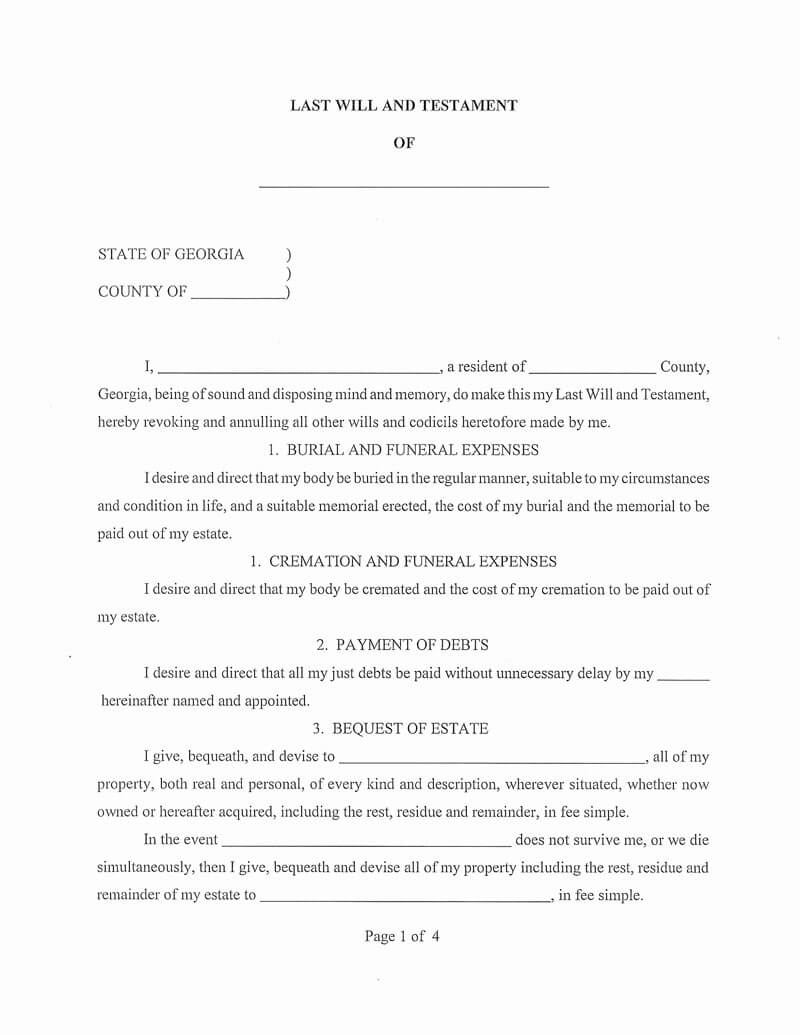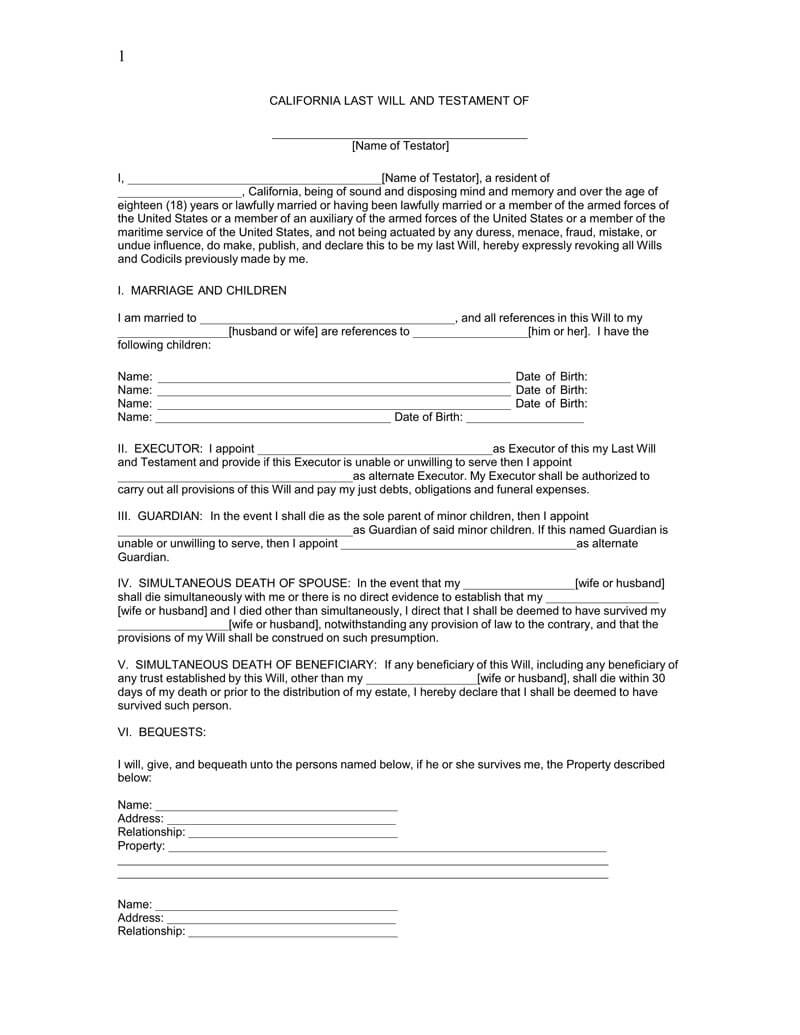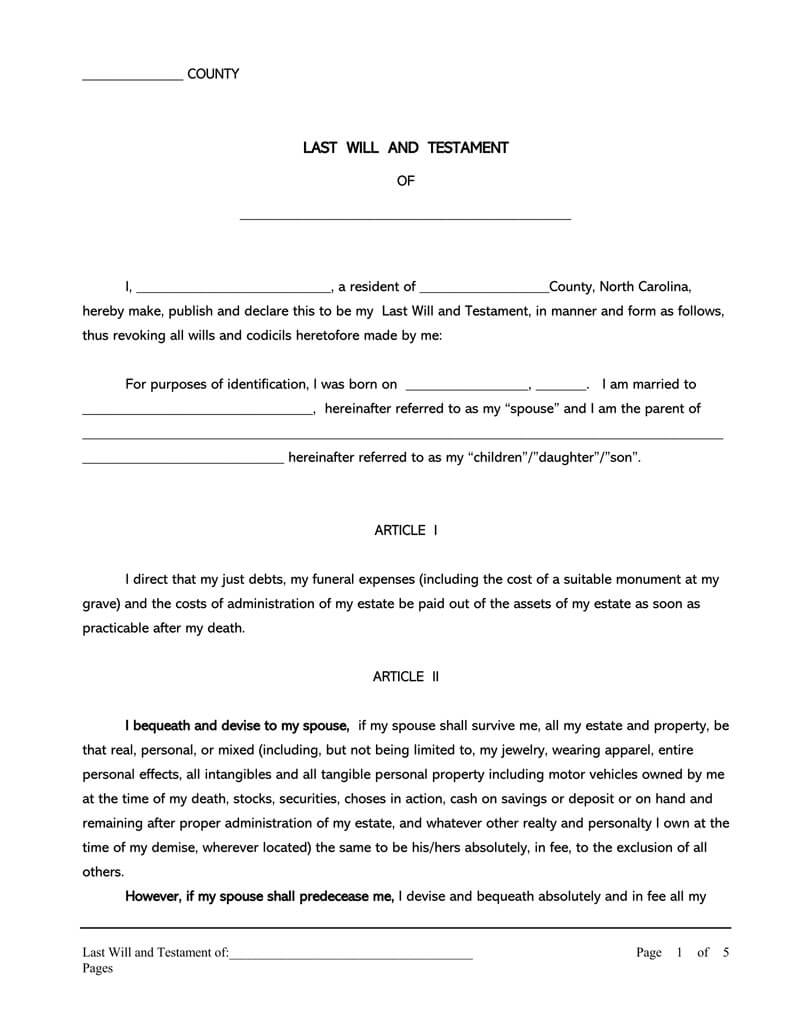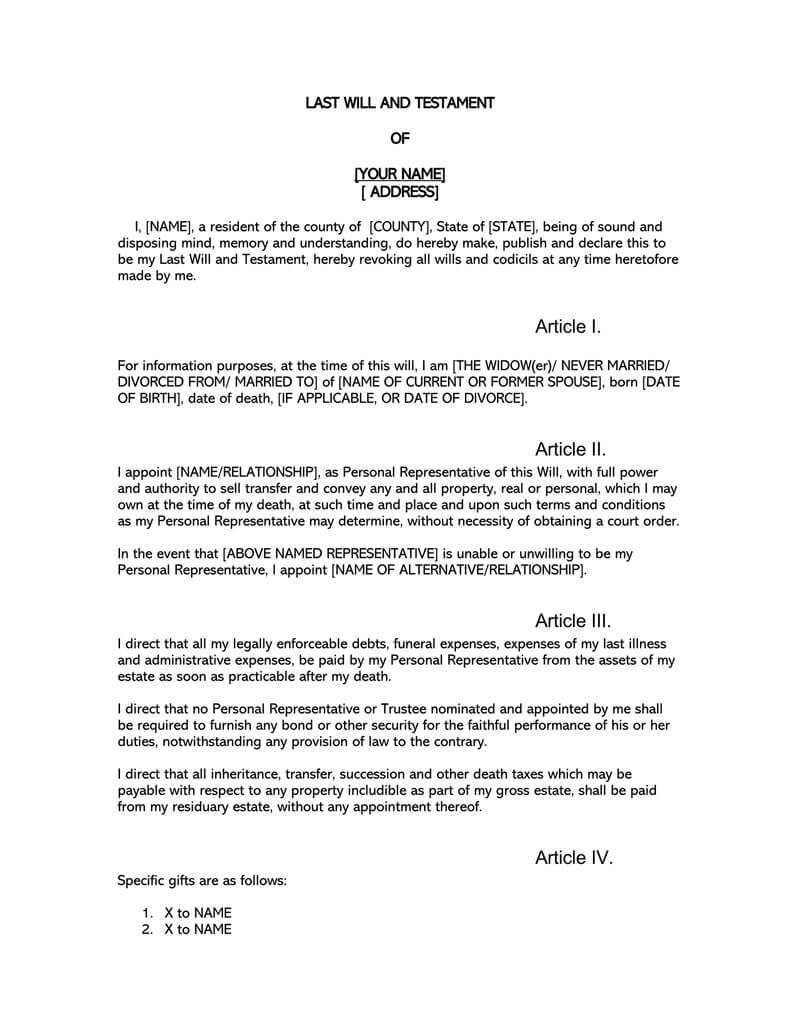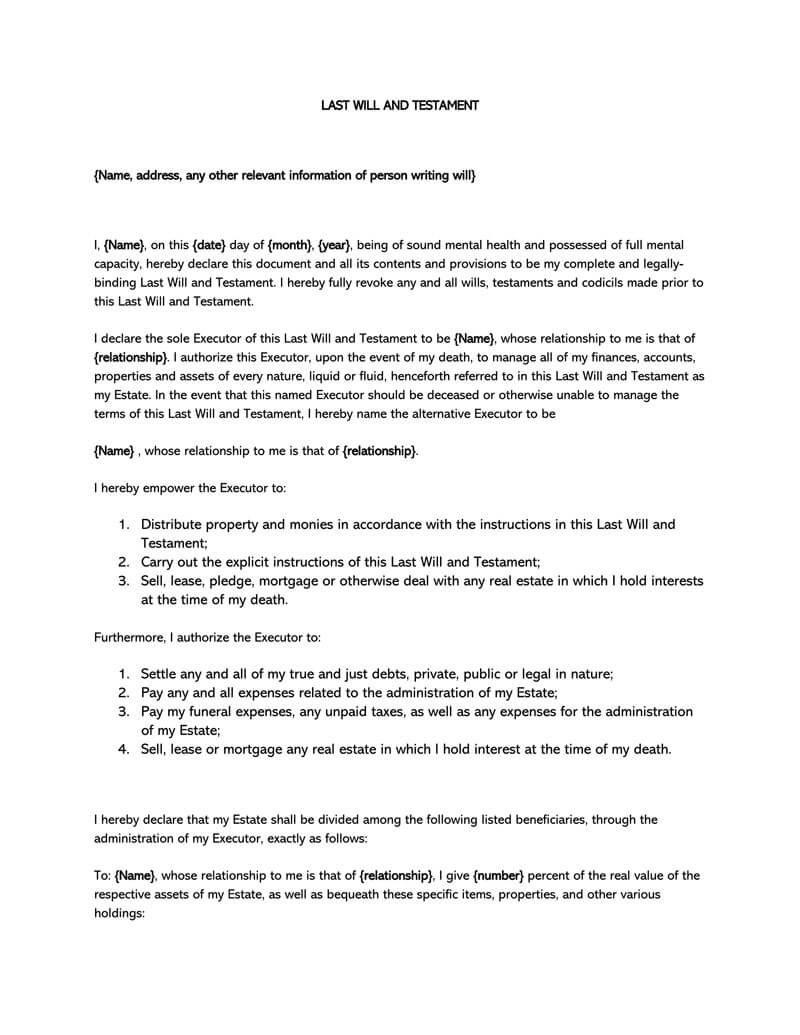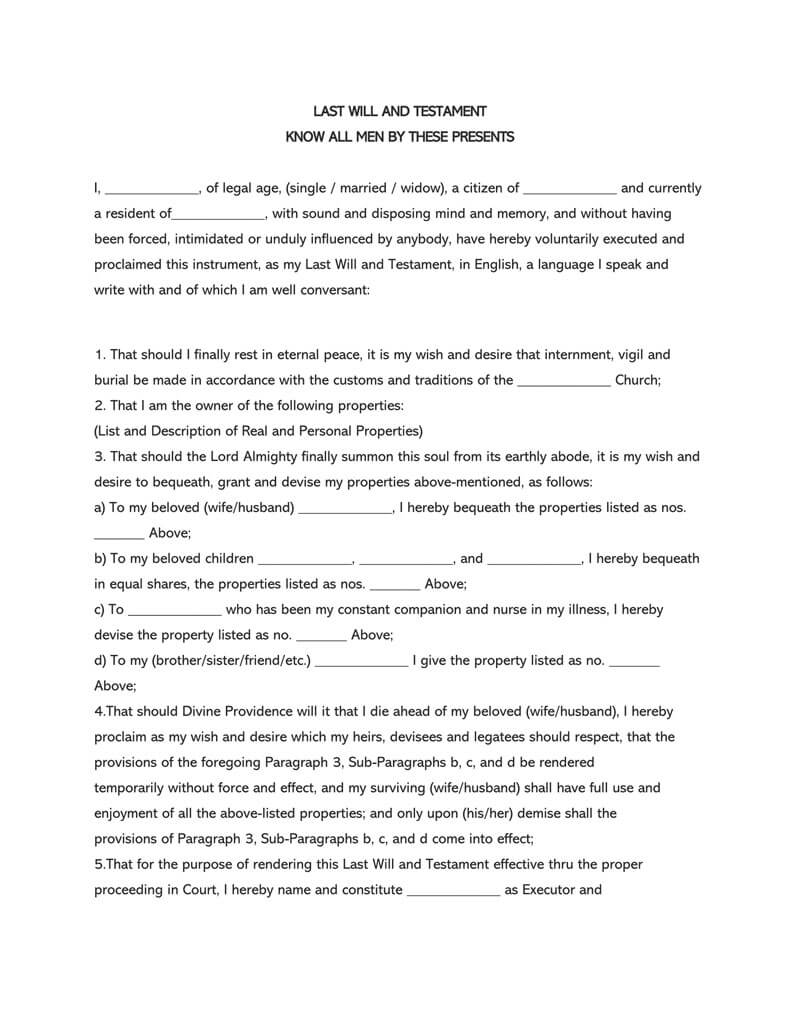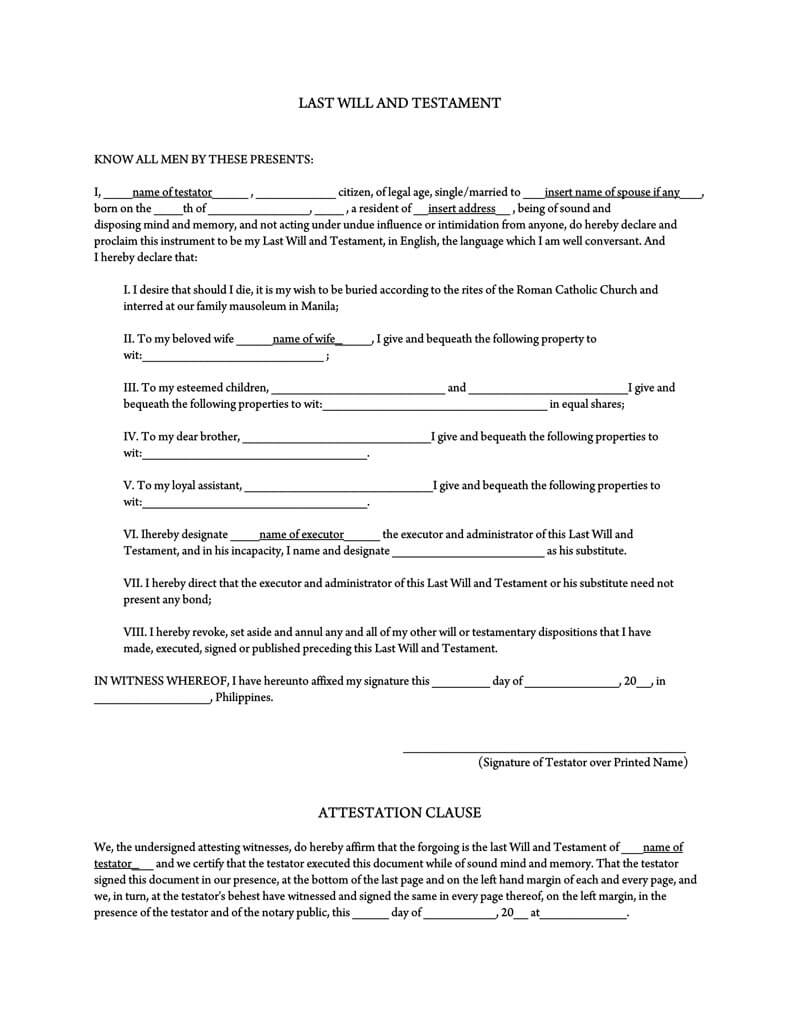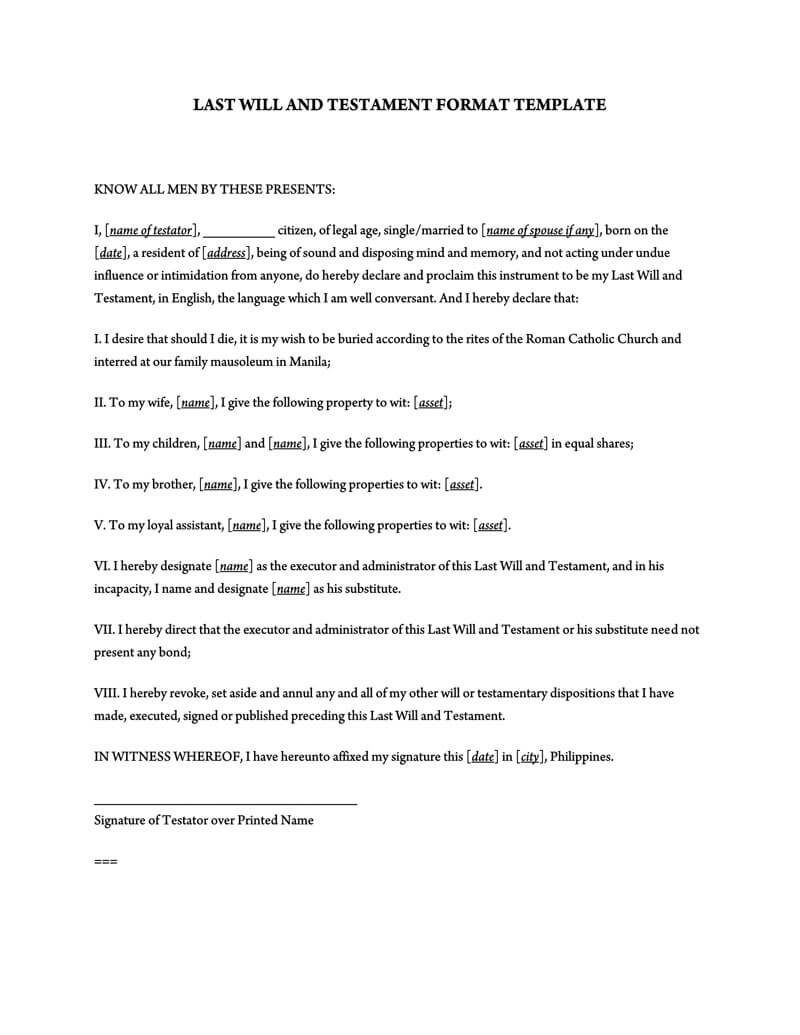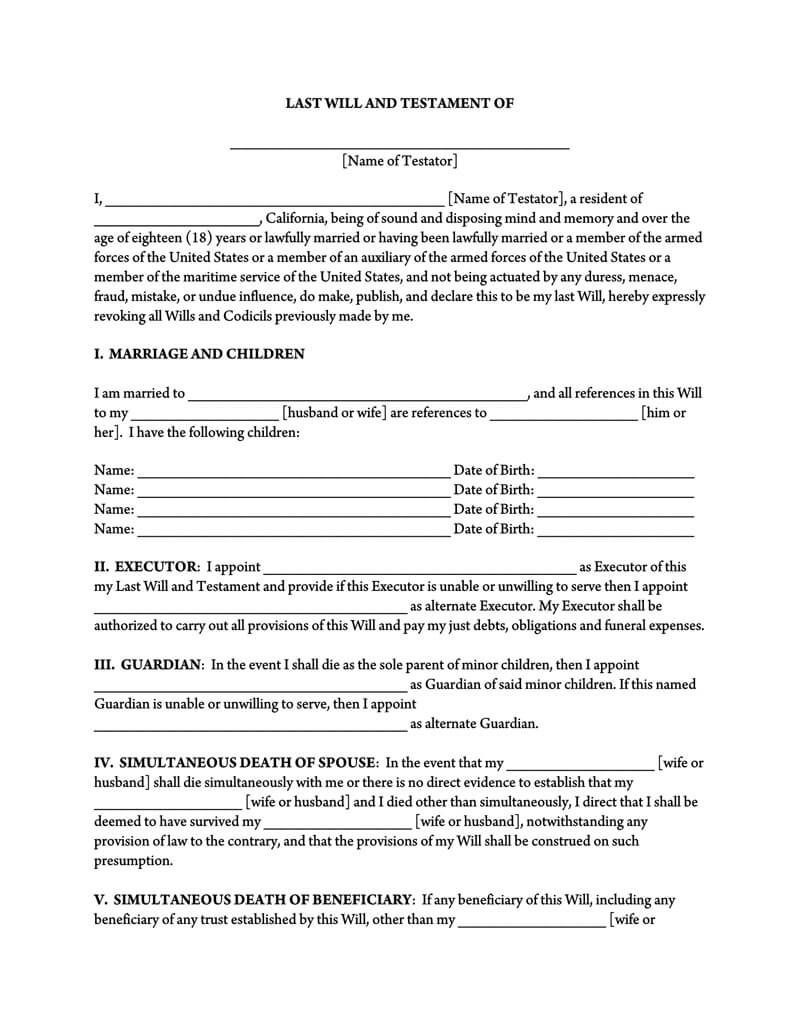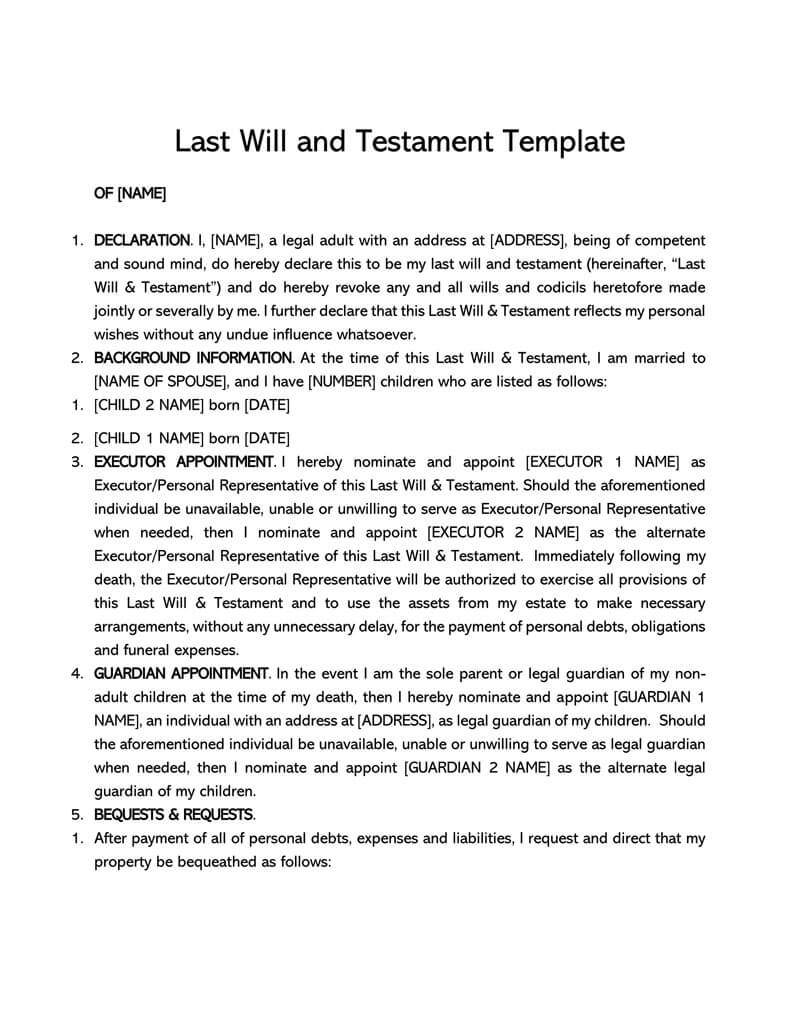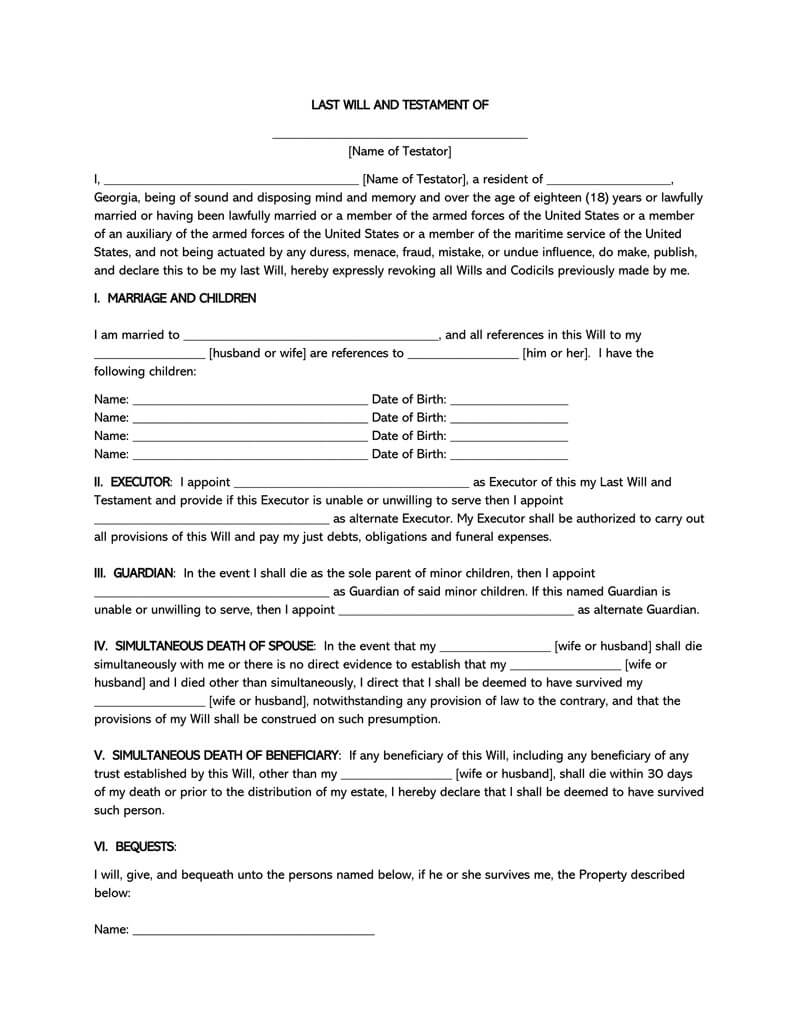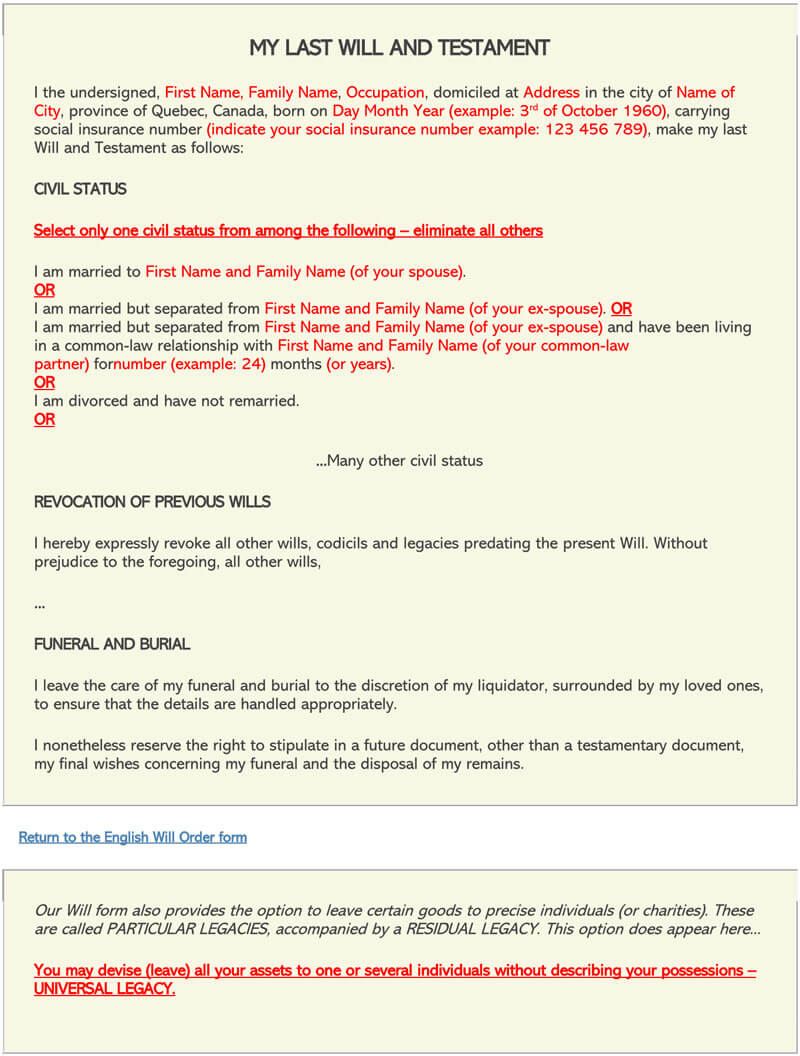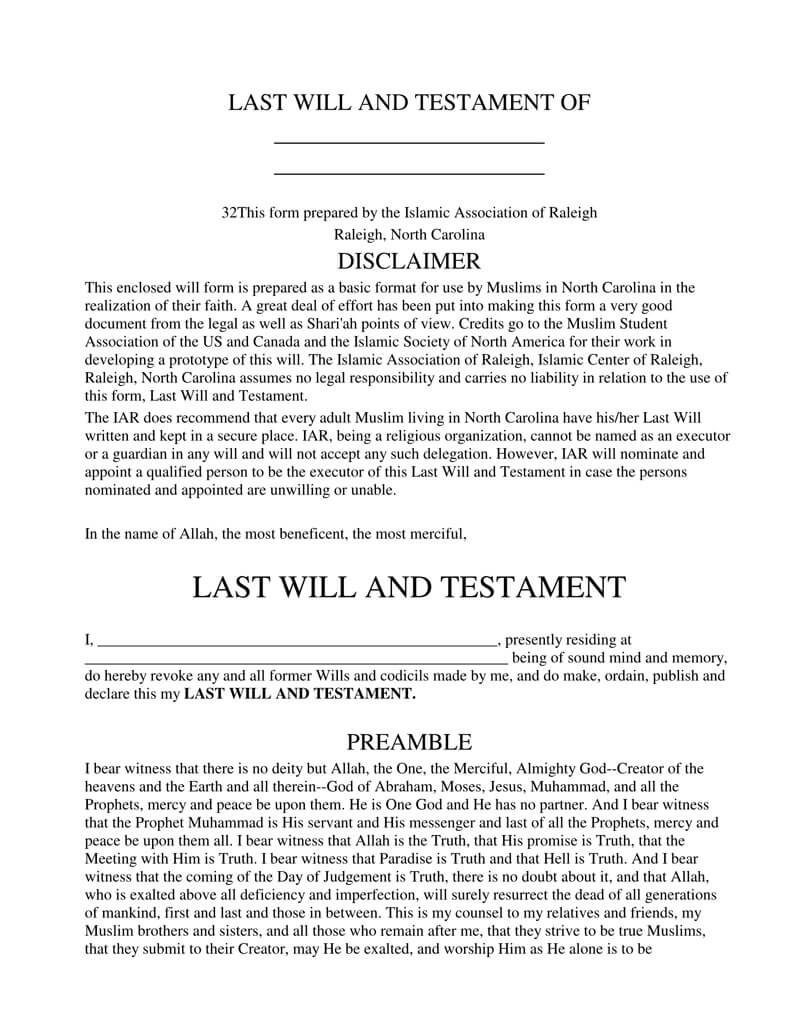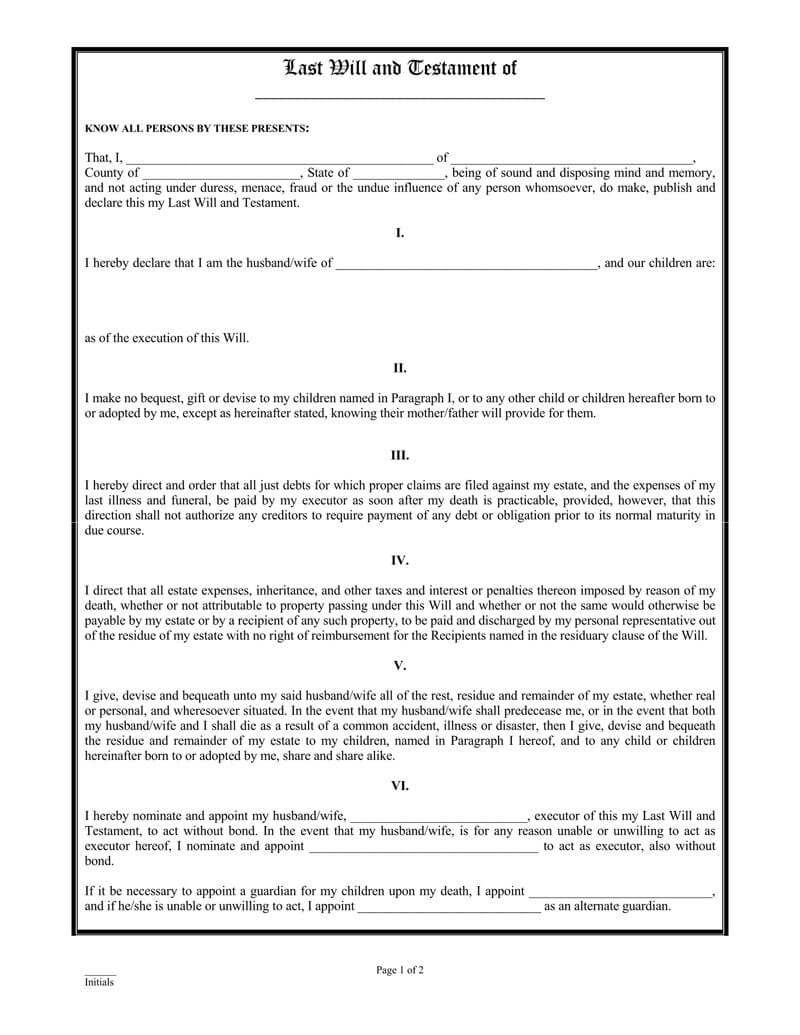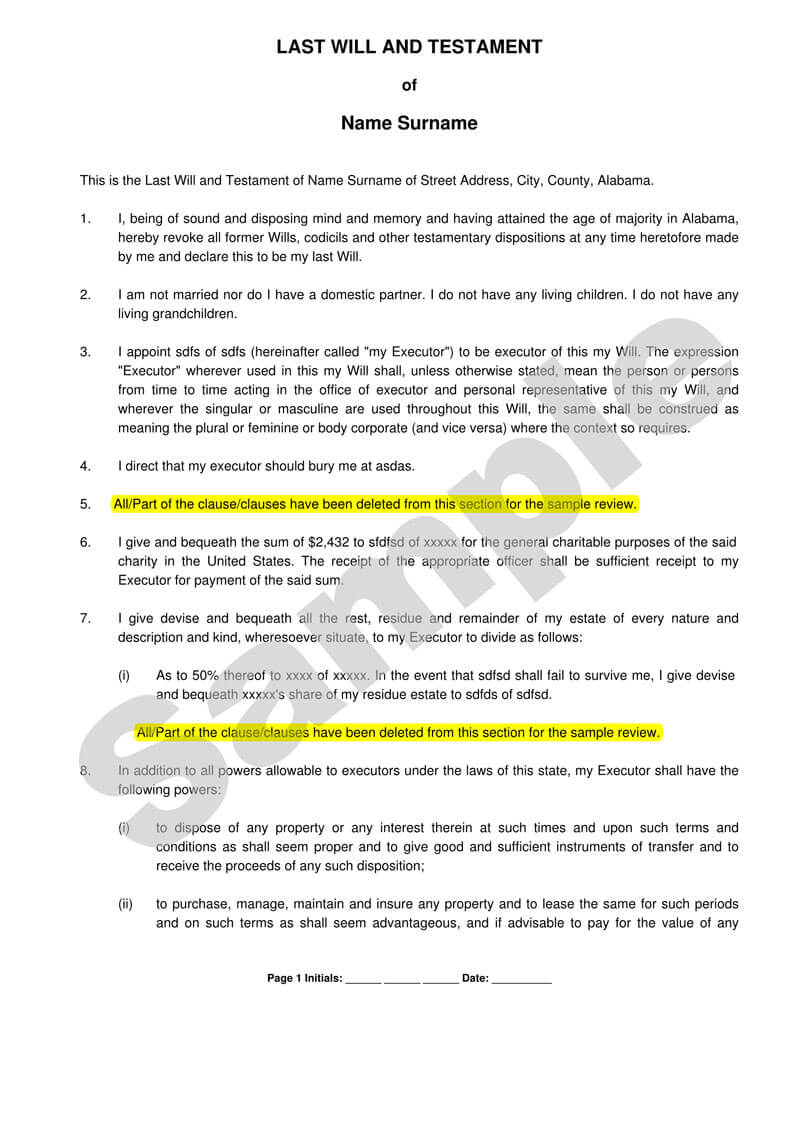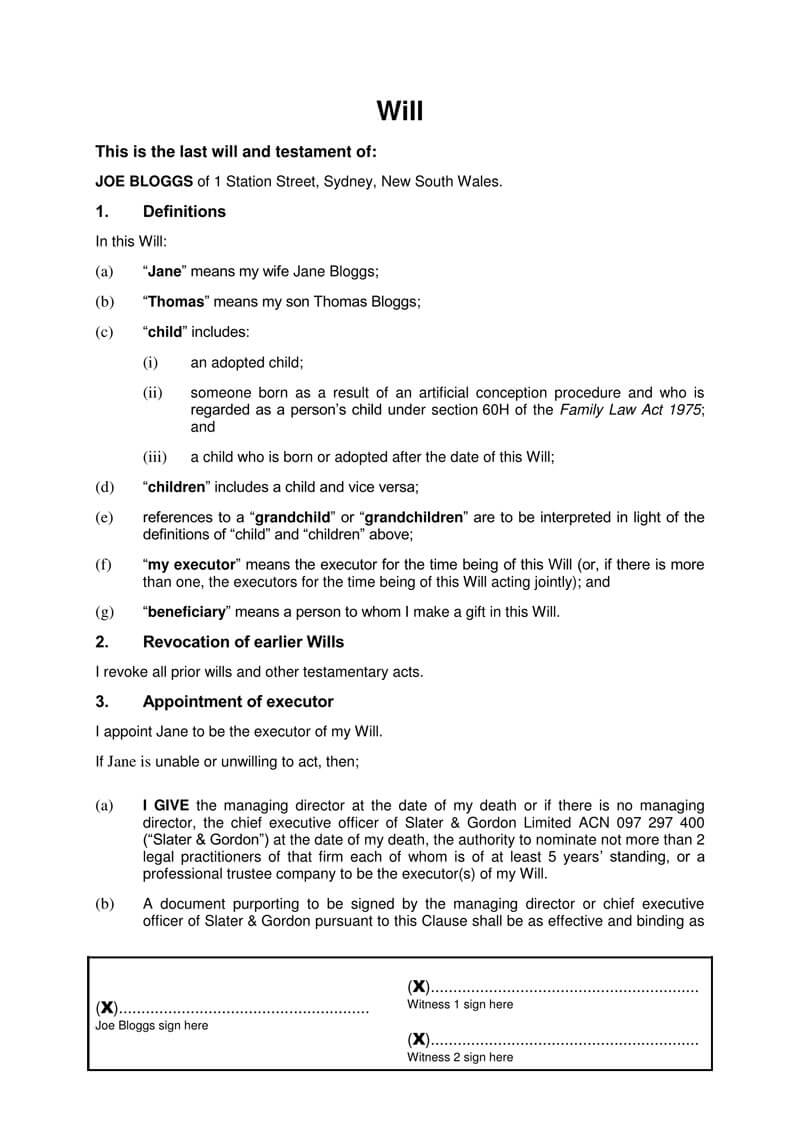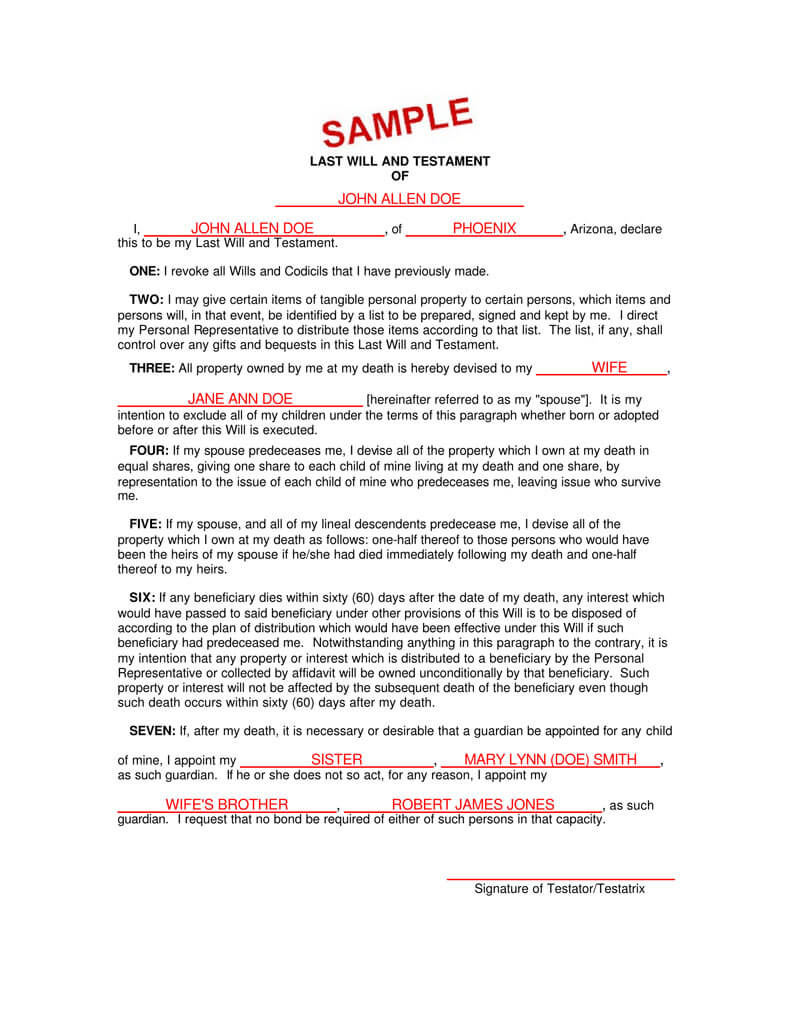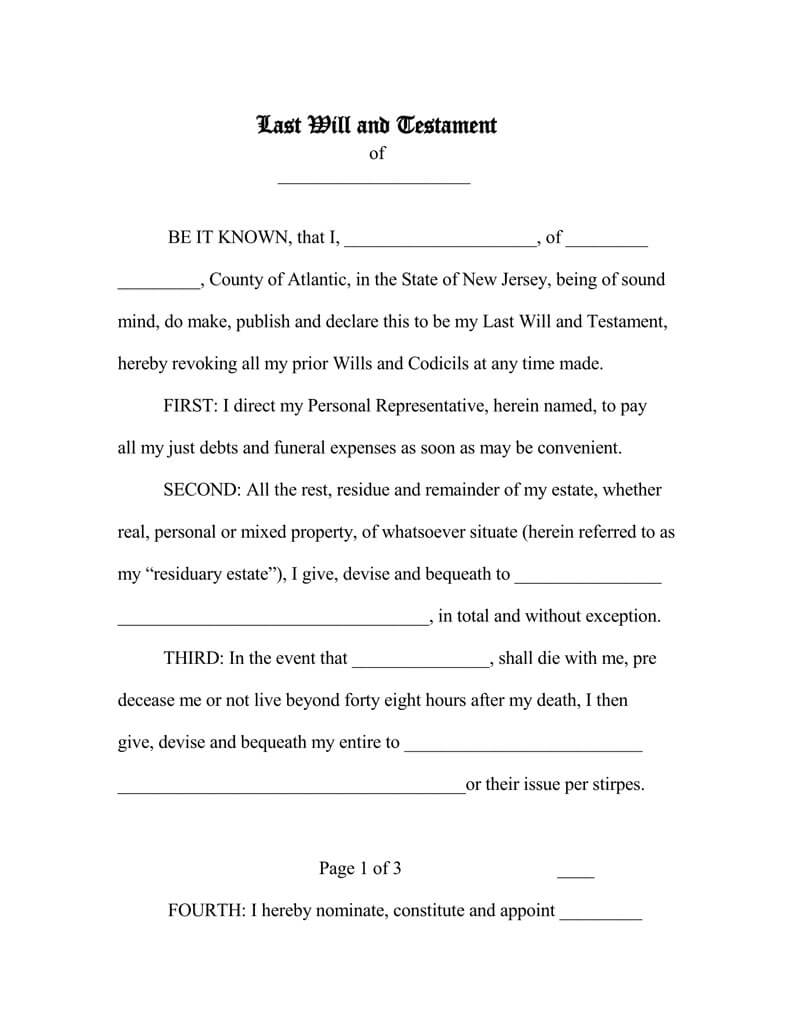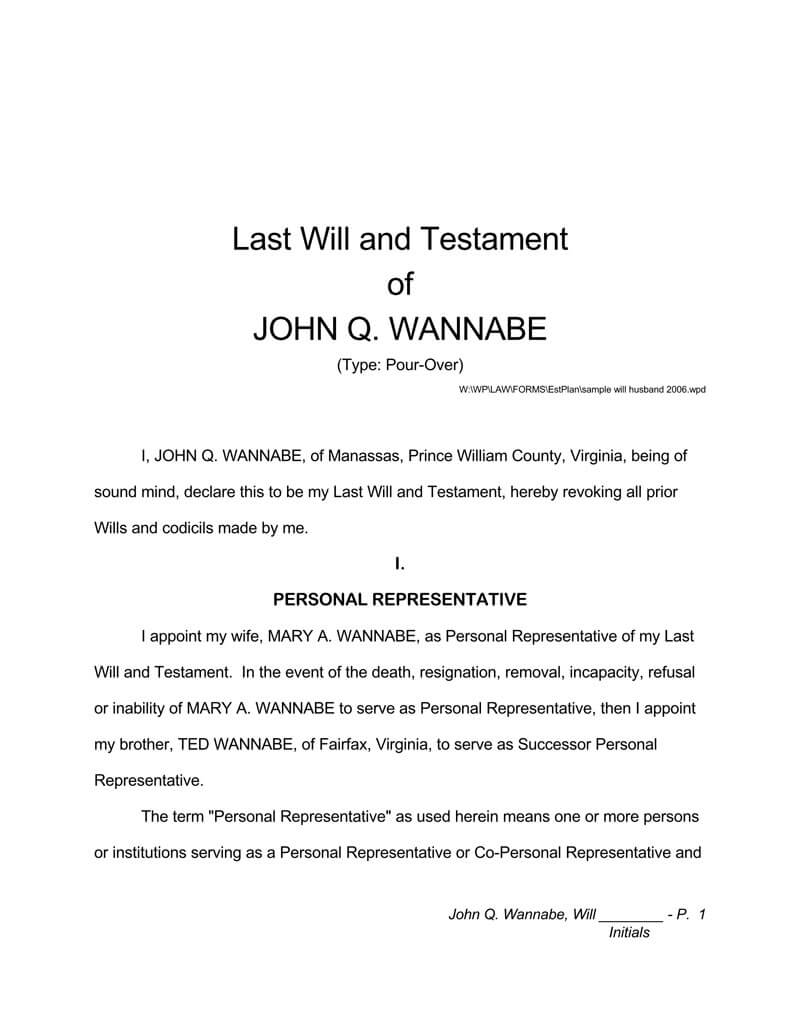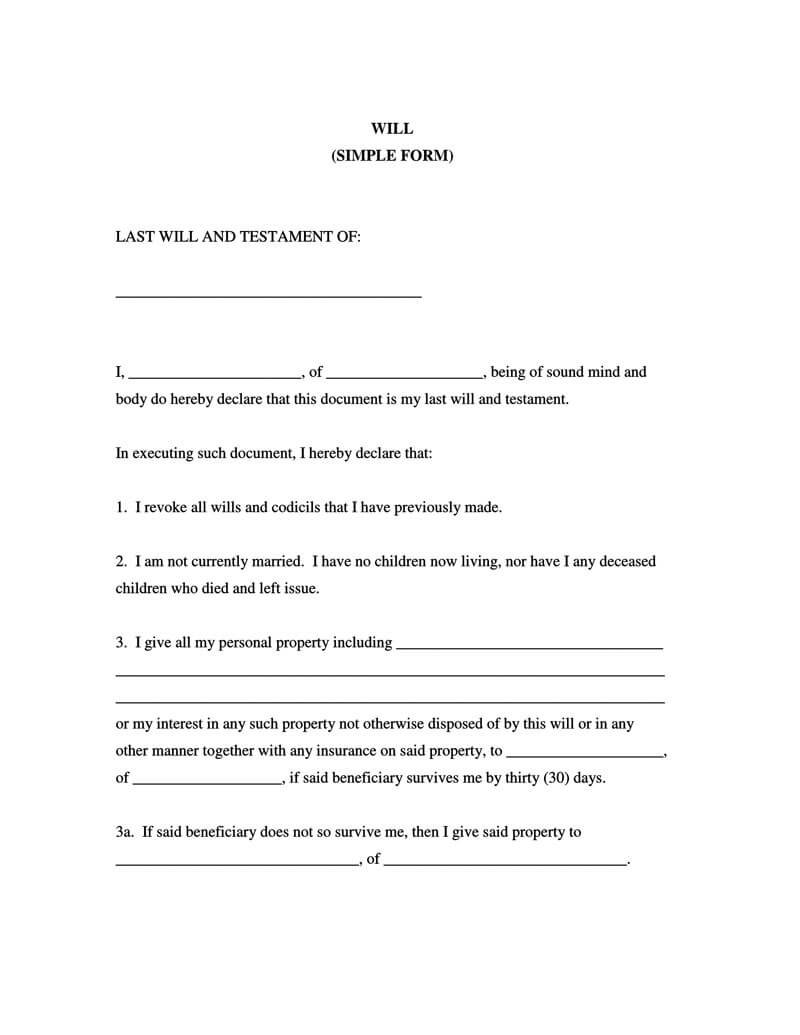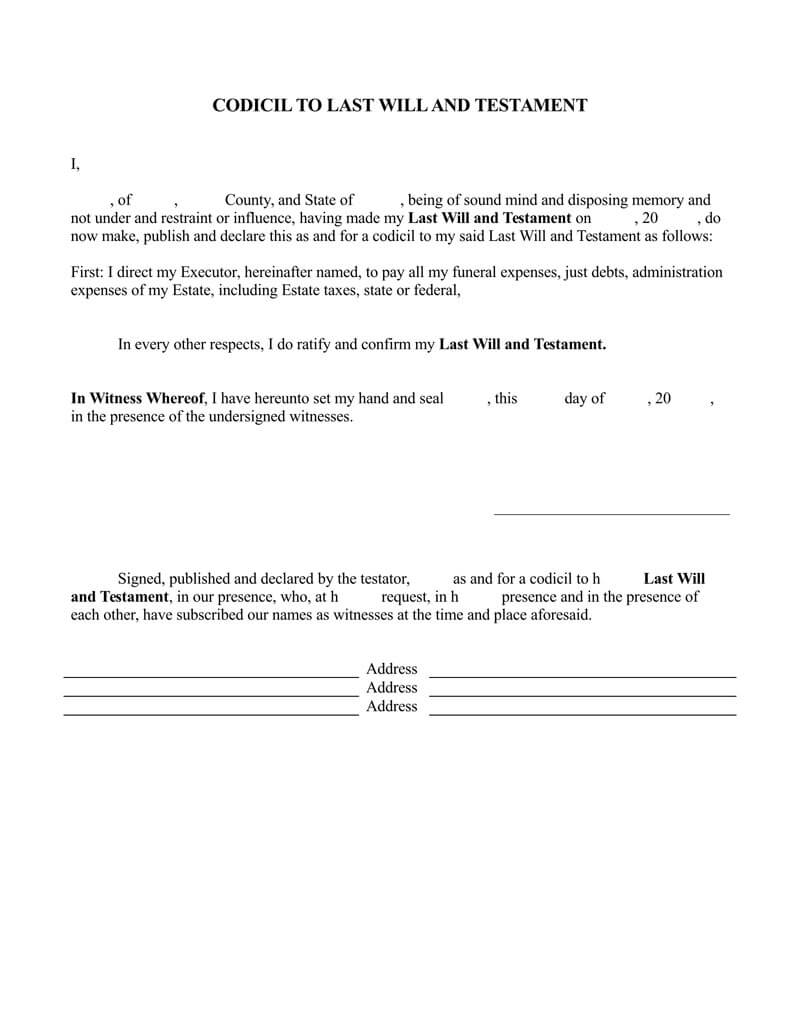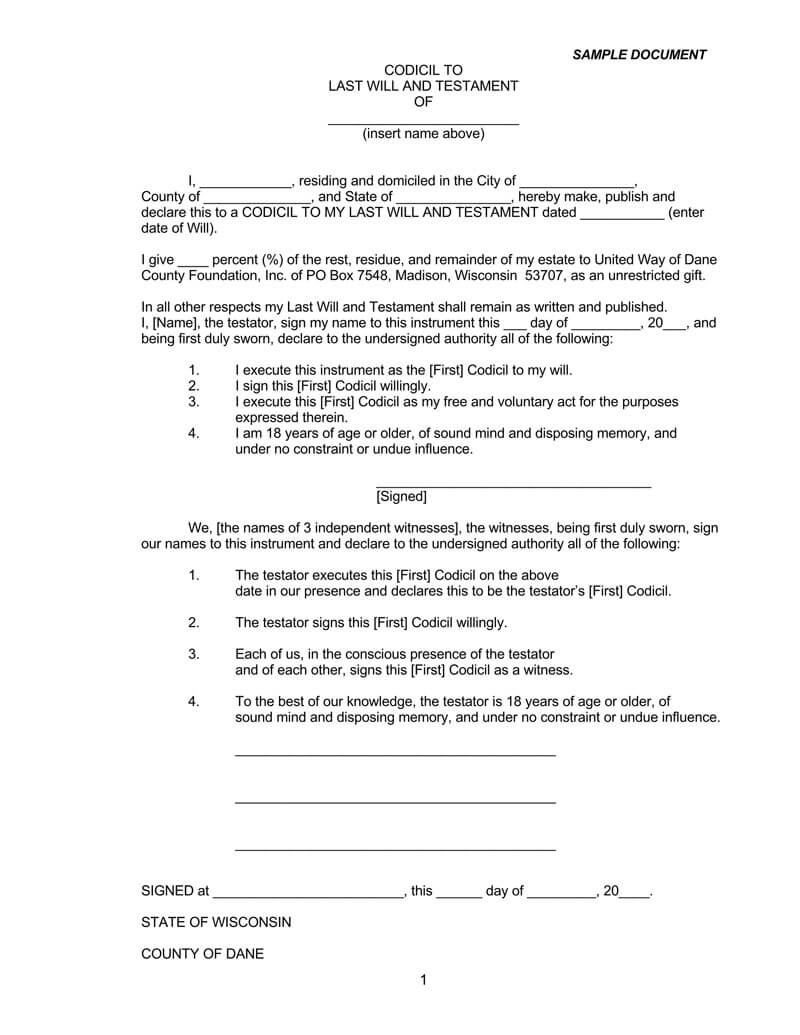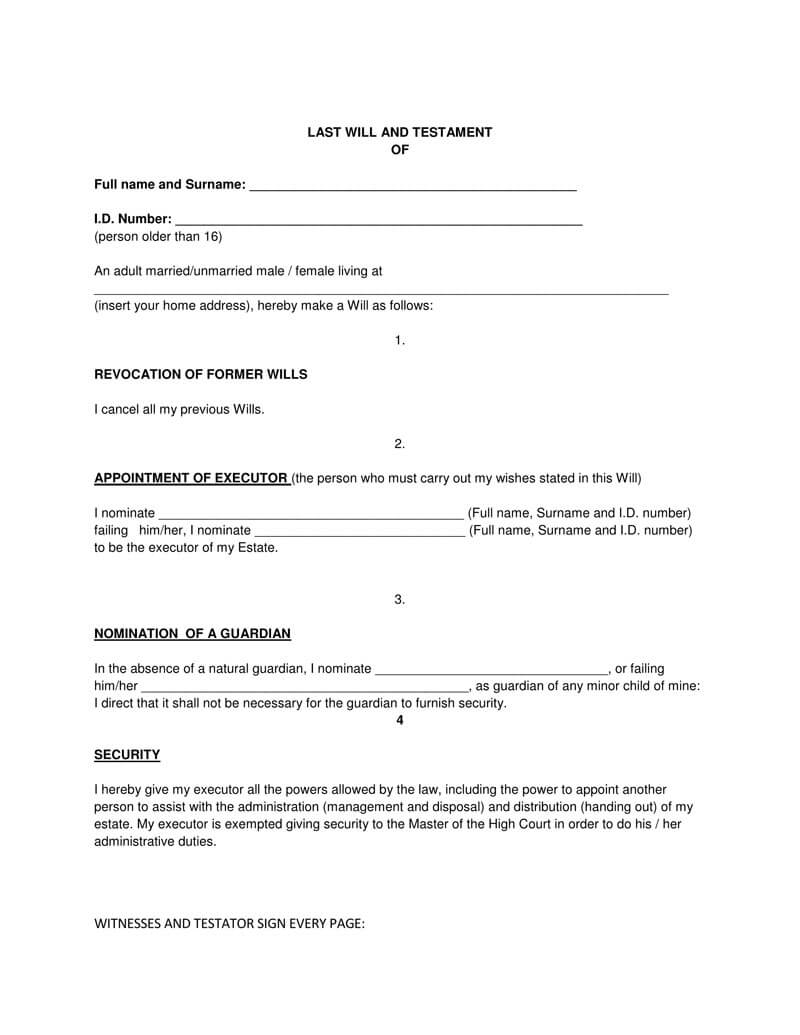The last will and testament form refers to a legal document that conveys the final wishes of an individual on dependents and possession
s. The last will of an individual outlines what one should do with the possessions and assets, whether the deceased person will leave them to another individual, a group, or even donate them to charities. It also indicates what happens to the other things they are responsible for, such as the management of accounts and interests, as well as the custody of dependents.
A will and last testament create the basis of an estate plan, which is the primary tool used to make sure that the estate of the deceased gets settled according to their wish.
When do you require a Last Will and Testament Form?
Regardless of your financial status or age, it’s never too late or too early to think about writing a will. Remember that valid wills are not only for the rich individuals but even those of modest means might also want to ensure that special items go to specific people and especially that their young kids are provided for. You should consider executing a will as soon as possible if:
- You have children
- You have any assets or possessions that you would like to give to particular individuals
- You have pets that you would wish to provide for after your demise
People Involved in the Last Will and Testament
When an individual executes a valid will, there are specific parties involved. It’s important to know the key parties whether you’re executing your will or whether you are a party to a will somebody else created. The key parties involved in a valid will execution include:
Testator
A testator refers to the individual who writes the Last will. He’s the person giving away his possessions by executing the will. After writing a will, the testator should sign the Last Will and Testament form along with the signatures of some two witnesses. Another individual can sign the will on behalf of a testator, in the presence and under the direction of a testator if, for one reason or the other a testator is not able to sign the will. However, the person should be at least 18 years of age to be a testator.
Executor
The executor is the person named by a testator and named in the last will and testament form to manage the estate of the deceased person within the terms and conditions of the will and also protect the possessions of the estate. An executor should comply with a variety of rules and laws that govern the management of the deceased possessions.
You can appoint anybody to the position of executor. It can be a member of the family or/and the beneficiaries of the Last Will and testament form. Executors should be individuals trusted by a testator, and they should have good organization and business skills. At times other individuals such as Public Trustees and legal practitioners are usually appointed as executors of the Last Will and testament form.
Beneficiaries
These are the individuals named in the valid will by a testator who will get some possessions from the estate. The beneficiaries can be businesses, nonprofits, and individuals among others. If you’re entrusted with some inheritance after the demise of the testator, you become one of the beneficiaries.
In the roles of beneficiaries, you are given certain responsibilities and rights for getting and managing the possessions, be they personal property, investments, or cash. The executor should reveal some information to you concerning the stipulations of the last will and testament form, but you’re not owed anything else beyond what has been allocated to your name.
Trustees
Trustees are the people named by a testator to manage the possessions for the benefit of all the beneficiaries who’ll receive the possessions at a future date. The trustee typically acts as the legal owner of all trust assets and is also responsible for the management of any assets held in a trust, filling tax for the trust, as well as distributing the possessions according to the terms of a specific trust.
Acting as a trustee can be a challenging task, and it carries a huge responsibility with it, especially, because they might be personally accountable when things go wrong. Choose your trustees wisely and discuss issues with them well in advance to ensure that they understand their responsibilities and what should be done.
Guardians
These are the people named by a testator to care for the young children if the testator dies or if any dependent kids are left without a living parent. The legal guardian will be fully responsible for your children’s well-being, in the same way, you’re responsible for your children now.
They will ensure the overall safety, protection, and emotional and physical growth of your children. A guardian is expected to provide food, clothing, education, shelter, and medical treatment for your children. If you don’t name legal guardians in your will, the court will appoint legal guardians for your children.
Last Will and Testament Forms (Word)
Last Will and Testament Templates (Word)
How to Make a Will?
Following are the steps to craft a last will:
Outline the assets
To get started, you should list all your important possessions. Then decide which properties should be left by other approaches, outside your last will. Remember that if you are married, each spouse will create a separate last will and testament form. You can only leave your share of the properties you own jointly with your marriage partner.
Appoint your beneficiaries
For most individuals, it is not difficult to decide who receives what. But you should be careful if you are considering leaving your children or spouse out of your last will. After making your first choices, always choose alternate beneficiaries, as well, in case your first choices do not survive you.
Appoint an executor
Each last will and testament form must name someone to act as an executor, to execute the terms of the last will and testament form. Ensure that the individual you have in mind is willing to act in that capacity, which means the job should not come as a surprise at all.
Choose a legal guardian for your young children
If you have little children at home, it’s important to appoint who will take care of them once you are gone. It’s also important to ensure that you and your designee have talked about your last wishes and are in agreement before you put them in your Last Will. The legal guardian will be fully responsible for your children’s well-being, in the same way, you’re responsible for your children now. If you don’t name legal guardians in your will, the court will appoint legal guardians for your children.
Choose a person to manage your children’s assets
If you leave some properties to young adults or children, you should appoint an adult to manage everything they inherit. To provide that person with authority over the kid’s inheritance, you should make them a property custodian or a property guardian under a law known as a legal trustee.
Write down your will
If you have made all the above decisions well ahead of time, then you can easily make your will in the shortest time possible with the help of the Last will and testament form. Most Will forms will provide you with a place to fill in your name, address, phone number, driver’s license number, social security number, mental status, and age. The last will and testament form will have included all this information already in the standard verbiage, meaning you will only have to validate that the information is there.
Sign your last will
Once you make your will, then it’s time to make the document legit. That means you should get two witnesses to sign your last will and testament form and then get your document notarized. You should date and sign your last will and testament form in the presence of the two witnesses because they will also have to sign the last Will and testament form too.
Remember you cannot name the witnesses as your beneficiaries in the Last Will and Testament form, so ensure that you select your witnesses carefully. You will need a third individual who will notarize your last will. You can get a notary at a government office, the post office, or the bank.
Store your last will safely
Tell your executor the place you have kept your will and how to access it when the time comes. You can keep your last will and testament form in a locked filing cabinet, in a safe in your home, or any location, you will feel comfortable. In spite of where you store your last will and testament form, allow your loved ones to know the place to help them access it with ease when that time comes.
Again, if you keep your last will and testament form in a place that requires a key, combination, or password for entry, you will have to share all that information too, or else the document will not be of much help when it is needed.
Last Will and Testament Examples (PDF)
Here are free editable templates that can be customized as per need:
Frequently Asked Questions
How to amend a Will?
A testator can use a codicil if the need to amend a Will arises. That can be for many reasons such as changing the personal representative, beneficiaries, executor, or any other aspect related to the transfer of possessions. A codicil should be attached to the Last Will and testament form and also signed according to State law. It is recommended that when a Will amendment happens through a codicil that two witnesses are authorized to swear under oath that they saw the signature of a testator.
Which State will govern my Will?
The original resident state of the testator or the state you pay your income taxes to is the state which governs your Last Will & Testament. However, your will should be compliant with the laws of the state in which it’s executed to be valid.
Which type of property can I include in my will?
By including specific properties in your Last Will and testament form, you can ensure that your possessions are given to the individuals you want in the specific way you want. These are the types of assets and property to include in your Will.
-Real property like real estate, buildings, and lands.
-Intangible personal property like bonds, stocks, and other kinds of business ownership, as well as royalties, patents, copyrights, and intellectual property, among others.
-Cash, including any money in savings accounts, money market accounts, and checking accounts among others.
-Unproductive property like valuable objects such as cars, jewelry, furniture, and artwork among others.
What happens if a beneficiary dies?
If a beneficiary dies before a testator, you can make amendments and remove that person from your Last Will. Else, if you have a second choice beneficiary, then your property will go to that individual. In the states that utilize the Uniform Probate Code, then a beneficiary should survive for a minimum of five days after your demise to inherit your property. If there are no alternate beneficiaries to inherit your possessions upon your demise, your Last Will and Testament form will then be subject to the Anti-Lapse Laws of your state.
What happens if there is no beneficiary?
If your will includes alternates for the primary beneficiaries, it is clear what happens to your estate if the first-choice recipients do not meet the survivorship requirements: The alternates get it. If your will does not have alternates, or an alternate has also passed on, you have something known as a “failed” or “lapsed” gift. Depending on the law of your state and how your will is written, the estate will either go to:
-the descendants of the primary beneficiary, under the anti-lapse law of your state, or
-the heirs of the deceased person under the law of the state, as if there was no will, or
-the residuary beneficiaries named in the Last Will and Testament form.
Can I appoint two executors?
It’s fine to appoint more than one executor in your Last Will and Testament form. That is to ensure that there’s someone appointed to execute the Estate if something happens to one of the named executors. In most cases, the testator names several close friends, family members, even an organization or a professional as Executors.
Can I appoint an executor who is also a beneficiary?
It is perfectly normal for an Executor to be one of the primary beneficiaries named in a Will. It is a common approach since it’s a great idea to ask somebody you know well and trust to become an Executor. It is, therefore, more likely that you will prefer naming at least one of your main beneficiaries, and most often this will be one of your primary beneficiaries.
